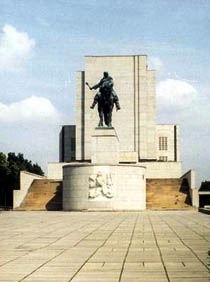
The National Memorial at Vítkov was not to be just a pantheon or a mausoleum
 |
Characteristics: national cultural monument since 1962
History: Vítkov entered historical consciousness mainly on July 14, 1420, when the Hussites led by Jan Žižka of Trocnov defeated the crusader armies of Sigismund of Luxembourg here. In memory of the battle, Vítkov began to be called Žižkův vrch - Žižkov.
Development: conceived as a Memorial to National Liberation in honor of those who fought for the creation of the Czechoslovak Republic. The symbolic groundbreaking was performed by President T. G. Masaryk on November 8, 1928. It was constructed between 1929 and 1938. The memorial was not intended to be just a pantheon; there were also considerations for parliamentary sessions here. During the occupation from 1939 to 1945, the building served the Germans as a military supplies warehouse and was heavily devastated. After 1945, the idea of the memorial expanded to honor the memory of those who fell in the Second World War. After 1948, it was misused for the promotion of the communist regime. It was opened to the public on May 17, 1951. In 1955, the rear section was expanded to include the Hall of the Soviet Army. Among other things, it served as a burial place for notable figures of the former regime - founders of the Communist Party, labor movement and presidents (Klement Gottwald, Antonín Zápotocký, Ludvík Svoboda). After 1990, some remains were returned to families, and the remaining unclaimed remains (including Gottwald's) were placed by the Communist Party of Bohemia and Moravia in a common grave at Olšany Cemetery.
NPV Building: constructivist building according to the design of architect Jan Zázvorka. The height of the main building is 31.5 meters, length 143 meters, and width 27.6 meters. The raw construction was completed in 1932, and work on the interior continued for another six years. Significant artists such as Jakub Obrovský, Karel Pokorný, Max Švabinský, Jan Štursa, Jaroslav Horejc, Otakar Španiel, and Josef Malejovský contributed to the decoration.
Klement Gottwald Mausoleum: opened on December 5, 1953; extensive technical facilities were built in the underground of the memorial for this purpose. It was abolished in March 1962. Poorly embalmed remains of Gottwald were cremated and placed in a sarcophagus in the Central Hall.
Grave of the Unknown Soldier and Military Columbarium (under the statue of Jan Žižka): a place of reverence and ceremonial acts. In 1949, the remains of the unknown soldier were transferred here from Dukla. The grave is covered with a granite slab for laying wreaths with the inscription "Glory to the heroes fallen for the fatherland," and a large state coat of arms is placed above the grave. In 2006, the remains of General Alois Eliáš and his wife were laid to rest here.
Statue of Jan Žižka of Trocnov: the largest bronze equestrian statue in the world (height: nine meters, length: 9.6 meters, width: five meters, weight: 16.5 tons). The author is sculptor Bohumil Kafka. It was completed in 1941, but unveiled only on July 14, 1950.
Present: The NPV has been managed by the National Museum since 2000. This year, reconstruction of the building begins, which will last until October 2009. A cultural center and a new exhibition "Crossroads of Czech and Czechoslovak Statehood in the 20th Century" will be established in the memorial.
The English translation is powered by AI tool. Switch to Czech to view the original text source.
2 comments
add comment
Subject
Author
Date
kulturní centrum?
Vích
07.06.07 04:01
divadlo komedie
František Procházka
08.05.10 09:42
show all comments












